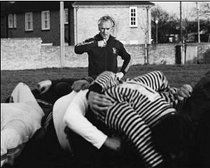
4. A Club in Transition
Part 4:
A Club in Transition
The 1950’s saw the club in good heart and a few Old Novos were making the grade within the Northumberland Senior County set up; Eric Reeve, Brian Reeve, G. M Thompson and Peter Taylor to name but a few. Taylor would have been captain in 1956-57 had it not been considered that his studies would stop him training regularly and giving him the necessary admin time. This turned out to be the correct decision as he became a top lawyer and judge. He is most famous for his inquiry into the Hillsborough disaster, known as the Taylor report and being appointed as Lord Chief Justice of England and Wales in 1992.
John Elders joined in 1959 and gave the club a huge lift, especially as a fellow member of RGS staff Bernard Bellwood, Yorkshire County scrum half, also arrived. Unfortunately the momentum did not last for long and the 1960’s overall were most disappointing. In 1963 the clubhouse was added to for the first time since the original build in 1927. An extension was built on top of the single storied changing rooms to the west of building. A County Presidents XV played an Elders led Novocastrians XV to mark the occasion.
Ups and downs had been many and in 1969 the club was at low ebb and it was decided to open the club to none “Old Boys of the R.G.S”. At the 1969 A.G.M the club dropped the “Old” from its title and became known as Novocastrians. This open membership did not bring about the automatic improvement some hoped for. These hopefuls should have known better- one of the initial results of their changed status was to alienate some Old Novocastrian rugby players. However, it didn’t take long for things to settle, and playing numbers gradually began to increase.
The opening of the club was probably too late and there was very little change in fortunes with playing records continuing to deteriorate up to a particularly disastrous season in 1975-76, when it was only the heroic efforts of captain David Taylor which kept the team going.
It was at this juncture that John Elders, only two years earlier the England Head Coach that led his country to the first ever test match win in South Africa, offered to take over the coaching so long as his suggestions for other positions were put in place. Hence in the summer of 1976 what became known as “the gang of four” came together to organise the playing side with Elders as coach, Colin Peacock captain, Jim Lewin chairman of selectors and Steve Lawson coordinating all the functions as membership and subscription secretary. They’re contribution shouldn’t go unnoticed - as it helped lead a much needed revival at Sutherland Park. John Elders’ role in the revival was crucial to the club’s success in the 1950’s and 60’s as a player, and again in the 1970’s as head coach. As a school master, his efforts whilst at the R.G.S were recognised. Elders was inducted into the Old Novocastrians Association’s ‘History of the R.G.S in Ten People’ in 2013.
The building blocks were in place and by attracting some experienced players back, and ensuring that a good number from the rugby playing schools in the area joined Novos, there was a gradual improvement particularly once the younger players became established. The club was now beginning to see a new lease of life and was succeeding on all fronts. The 1980’s was a very successful decade for the club and in 1986 Jim Pollock (who had just re-joined the club after gaining 8 caps for Scotland while at Gosforth), Mark Christopher, Andy Marwick and Graham Ward all played in the same Northumberland County side.
Photograph:
Above: England training session before Australia game, November 1973. England coach John Elders oversees a scrum in training.

